Markham, Ontario
| Town of Markham | |||
|
|||
| Motto: The Mark of Excellence, Canada's High Tech Capital | |||
|
|
|||
| Coordinates: | |||
| Country | |||
|---|---|---|---|
| Province | |||
| Regional Municipality | York Region | ||
| Communities | Buttonville, Cornell, Milliken, Unionville | ||
| Settled | 1794 | ||
| Incorporated | 1972 (town) | ||
| Government | |||
| - Mayor | Frank Scarpitti | ||
| - Deputy Mayor | Jack Heath | ||
| - Regional Councillors | Jim Jones, Tony Wong, Gordon Landon | ||
| - MPs | Peter Kent (Con) - Thornhill, John McCallum (LPC) - Markham—Unionville, Paul Calandra (Con) - Oak Ridges—Markham | ||
| - MPPs | Peter Shurman (PC) - Thornhill, Michael Chan (OLP) - Markham—Unionville, Helena Jaczek (OLP) - Oak Ridges—Markham | ||
| Area | |||
| - Total | 212.47 km² (82 sq mi) | ||
| Population (2006)[1] | |||
| - Total | 261,573 (Ranked 16th) | ||
| - Ethnicity | 34.4% White 34.2% Chinese 17.3% South Asian 3% Black 11.1% Other |
||
| Time zone | EST (UTC-5) | ||
| - Summer (DST) | EDT (UTC-4) | ||
| Area code(s) | 905,289 | ||
| ISO 3166-2 | CA-ON | ||
| Civic Centre | Highway 7 and Warden Avenue | ||
| Website: http://www.markham.ca/ | |||
Markham (pronounced /ˈmɑrkəm/; 2006 population 261,573) is a town located in the Regional Municipality of York, Ontario, Canada. It is directly north of Toronto, and is part of Toronto's Census Metropolitan Area. Despite its qualifications regarding population, it has not had the title of city conferred upon it by the province, and retains its legal status as a town. Markham is one of the fastest-growing communities in Canada. Markham is also the largest town in Canada [2]
Markham is the fourth-most populous municipality in the Greater Toronto Area, after Toronto, Mississauga, and Brampton. Thus, it is home to many cultures. It also claims to be Canada's Hi-Tech Capital with a number of key companies in the area, such as IBM, Motorola, Toshiba, Lucent, Sun Microsystems, Apple, AMEX, and home to the head office of graphics card producer ATI (now part of AMD).
History and Present
Markham was first surveyed as a township in 1793 by William Berczy (Johann Albrecht Ulrich Moll 1744-1813), and settled in 1794.
In 1794, William Berczy led 75 German families from New York State to Markham Township, an area known as German Mills today. Each family was granted 200 acres (0.8 km²). Because of hardships, many returned to York (now Toronto) and Niagara. The area became a ghost town.
From 1803 to 1812, the largest group of settlers were Pennsylvania Germans, most of whom were Mennonites. These highly skilled craftsmen and knowledgeable farmers had the best chance for survival because they had already survived harsh conditions in Pennsylvania. From 1830 on, many Irish, Scottish and English emigrated to Upper Canada to escape the famine and overpopulation of their homeland.
Markham's early years blended the rigours of homesteading with the development of agriculture-based industries. The many rivers and streams in the Township soon supported water-powered saw and grist mills and, later, woollen mills. With improved transportation routes, such as the construction of Yonge Street in the 1800s, along with the growing population, urbanization increased. By 1857 most of the Township had been cleared of timber and was under cultivation. Villages like Thornhill, Unionville and Markham greatly expanded. In 1871, the Toronto and Nipissing Railway company built the first rail line in Markham. This rail line is now used for commuter train services (i.e. GO Trains)
The first form of structured municipal government occurred in 1850 when the Township of Markham was created. Markham was then incorporated as a town in 1972.
Ever since Markham incorporated as a town, Markham grew quickly as a result of urban sprawl in the Greater Toronto Area. For instance, in 1976 (4 years after Markham's incorporation as a town), Markham's population was approximately 56,000. Since that time, the population has more than quadrupled. Explosive growth in new subdivisions has led to a jump in population since the 1980s. Much of Markham's farmland has disappeared, now mostly found north of Major MacKenzie Drive. Controversy over development of the environmentally sensitive Oak Ridges Moraine will likely curb development of Markham's northern portion.
At present, Markham comprises six major communities: Buttonville, Cornell, Markham Village, Milliken, Thornhill, and Unionville. Since the 1980s the town has been recognized as a suburb of Toronto. Many high-tech industries have located in Markham for the relative abundance of land, low tax rates and good transportation routes. ATI Technologies (now known as AMD), IBM Canada, Apple Computer Canada, Motorola Canada and many other well-known companies have chosen Markham as their home in Canada. Hence, the town has been branding itself as Canada's "High-Tech Capital".
Geography
Markham covers 212.47 square kilometres. It is bounded by 5 municipalities. To the west, the town is bounded by Vaughan (boundary is at Yonge Street between Steeles Avenue and Highway 7), and Richmond Hill (boundary is at Highway 7 from Yonge Street to Highway 404 and at Highway 404 from Highway 7 to somewhere between 19th Avenue and Stouffville Road). To the south, Markham is bounded by the City of Toronto (boundary is at Steeles Avenue). To the north, it is bounded by the Town of Whitchurch-Stouffville (boundary is from Highway 404 to York-Durham line somewhere between 19th Avenue and Stouffville Road). And to the east, Markham is bounded by the City of Pickering at York-Durham Line. Markham's town centre is at .
Topography
Markham's average altitude is at 200 metres. The town is intersected by two rivers, Don River, and Rouge River, as well as their tributaries. Markham has mainly flat, gently rolling hills. To the north, the Oak Ridges Moraine, which further elevates the elevation towards the north end of the town.
Climate
Due to Markham's proximity to Toronto, Markham shares the same climate as Toronto. On an average day, Markham is generally one to two degrees celsius cooler than in Downtown Toronto.
Demographics
According to the Canada 2006 Census:[3]
| • Population: | 261,573 (+25.4% from 2001) |
| • Land area: | 212.58 km2 (82.08 sq mi) |
| • Population density: | 1,230.5 inhabitants per square kilometre (3,187 /sq mi) |
| • National population rank (out of 5,008): | Ranked 16th |
| • Median age: | 38.1 (males: 37.0, females: 38.9) |
| • Total private dwellings: | 81,181 |
| • Dwellings occupied by permanent residents: | 77,191 |
| • Median household income: | $77,163 |
Markham has experienced tremendous growth since the 1980s. The Canadian census of 2006 states that the population of Markham in 2006 is 261,573, which is a 25.4% increase from the 2001 census.[2]
According to the 2006 census, 65.4% of the population consists of visible minorities. In 2006, the largest racial groups in Markham were:
- White: 34.4%
- Chinese: 34.2%
- South Asian: 17.3%
- Black: 3.1%
- Filipino: 2.8%
- All Others: 8.2%
Immigration characteristics (2006):
- Canadian-born population: 42.6%
- Foreign-born population: 56.5%
- Non-permanent residents: 0.9%
Total population by religion (2001):
- Catholic: 25.5%
- Protestant: 20.6%
- Hindu: 5.7%
- Muslim: 5.3%
- Jewish: 5.3%
- Christian Orthodox: 4.9%
- Other Christian: 4.3%
- Buddhist: 3.4%
- Sikh: 1.6%
- Other Eastern Religions: 0.2%
- Other religions: >0.1%
- No religious affiliation: 23.1%
Government
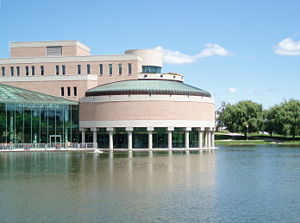
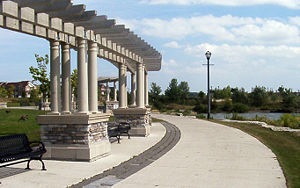
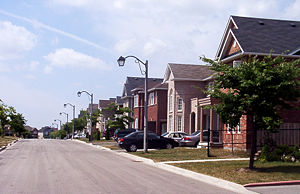
The Markham Town Council consists of the mayor, four regional councillors and eight ward councillors, each representing one of the town's eight wards. The mayor of Markham is Frank Scarpitti, who replaced the now retired Donald Cousens, former PC MPP for Markham and Presbyterian church minister). The mayor and four regional councillors are elected by the community to represent the Town of Markham at the regional level.
The members of council are elected by the municipality's voters. Councillors are paid by the municipality for their services, but in many municipalities, members of council usually serve part-time and work at other jobs as well.
The current members of council were elected by the residents to a four-year term of office, in accordance with standards set by the province. The selection of members for the offices of mayor and regional councillors are made town-wide, while ward councillors are elected by individual ward.
The town offices are located at the Markham Civic Centre at Highway 7 (Ontario) and Warden Avenue. The previous offices on Woodbine Avenue have disappeared (a funeral home is on the site), but the historic town hall on Markham Main Street is now a restored office building.
- See also: List of mayors of Markham, Ontario
The Mayor's Youth Task Force was created to discuss issues facing young people in the town and to plan and publicize events. Its primary purpose is to encourage youth participation within the community.
Law and order
There are no courts in Markham, but the town is served by an Ontario Court of Justice in Newmarket, as well as an Ontario Small Claims court in Richmond Hill, Ontario. The Ontario Court of Appeal is located in Toronto, while the Supreme Court of Canada is located in Ottawa. Policing is provided by York Regional Police at a station (5 District) at the corner of McCowan Road and Carlton Road and Highway 7. Highway 404, Highway 407 and parts of Highway 48 are patrolled by the Ontario Provincial Police.
Town issues
Like most cities and towns in the Greater Toronto Area, Markham has a few issues it must deal with:
Urban growth
There is a desire by the Town to control urban sprawl by requesting higher density for new development. The town plan calls for more growth along Highway 7 and less towards the farm land to the North. A similar development in Cornell promotes the need for services to be closer to residences.
Transit plan
Linked to the concern of urban growth, Markham through York Region Transit (YRT) has implemented a transit system called Viva to ease the strain on the region's congested roads. Viva is similar to YRT but is used as an express bus service with the ability to alter immediate traffic signals so it will not be late. The YRT is also planning to build a transit terminal somewhere near Cornell soon.
Markham's neighbourhoods and communities
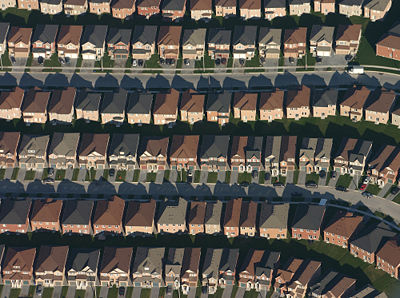
Markham is made up of many communities (many of which, despite being technically suburban districts today, are still signed with official 'entering community' signs on major roads) each with a distinctive character:
- Angus Glen
- Armadale
- Berczy Village
- Box Grove
- Buttonville
- Cachet
- Cashel
- Cedar Grove
- Cornell
- Crosby
- Downtown Markham
- Dickson's Hill
- Gormley
- Greensborough
- Legacy
- Locust Hill
- Markham Village
- Milliken Mills
- Quantztown
- Raymerville/Markville East
- Rouge Fairways
- Sherwood - Amber Glen
- Thornhill
- Unionville
- Vinegar Hill
- Wismer Commons
Thornhill and Unionville are popularly seen as being separate communities. Thornhill actually straddles the Markham-Vaughan town line (portions of it in both municipalities).
Parks
- Further information: List of parks in Markham, Ontario
Culture
Until the 1970s, Markham was mostly farmland and marsh, which is still reflected in events like the Markham Fair. Today Markham boasts as Canada's High Tech Capital with many new major technology and large corporations choosing to locate their offices within the town. Markham is in the process of building a new downtown, bordered by Kennedy Road, Highway 7, Warden Ave. and the new Enterprise Avenue. Markham is now very diverse, most notably with a large Chinese population, with Pacific Mall, First Markham Place, Peachtree Centre and other major Chinese stores and centres within the vicinity. Markham is known as one of the best places to live in Canada, and has a balance of both new and old (2 main streets).
Markham is also known for its love of performing arts, demonstrated most profoundly in the critically and audience acclaimed Markham Little Theatre [2]. Thriving for the past 40 years and presenting over 100 plays, Markham Little Theatre's performances draws audience members from residents and those of neighbouring communities.
Markham Youth Theatre [3] also demonstrates the love of arts in the youth of the town. A small theatre company completely run and organised by youth in the area.
The Markham Public Libraries system has 6 branches, with over 600,000 collections in total.
Education
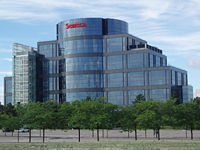
Markham is served by a number of high schools. St. Robert Catholic High School, Markville Secondary School, Pierre Elliott Trudeau High School, Unionville High School, Middlefield Collegiate Institute, St. Augustine CHS, Brother Andre CHS, Markham District High School, Milliken Mills High School, Thornlea Secondary School, Father Michael McGivney Catholic Academy, Bur Oak Secondary School, Thornhill Secondary School, and Bill Crothers Secondary School all have consistent high scores on standardized exams and have some of the highest rate of graduates attending universities.
Markham currently does not have any universities itself, but Seneca College has satellite campuses at Highways 7 and 404 and at Buttonville Airport. Most high school graduates continue to post-secondary education in universities across Ontario. There are local transit services that connect to York University, Ryerson University, University of Ontario Institute of Technology and the University of Toronto, as well as to Toronto campuses of Seneca College, Centennial College, George Brown College, Humber College, The Michener Institute, Durham College and Sheridan College.
Economy

In the 19th century, Markham was a vibrant, independent community with distilleries and breweries around the Highway 7 and 48 intersection. The Speight Wagon Works exported products around the world, and it was said that Markham was more active than York (former name for Toronto) was early on.
Today, it claims to be Canada's Hi-Tech Capital with a number of key companies in the area, such as IBM, Motorola, Toshiba, Lucent, Sun Microsystems, Apple Inc., Genesis Microchip, and is home to the head office of graphics card producer ATI (recently merged with AMD).
Markham also maintains economic and cultural cooperation agreements with the city of Laval, Quebec (which is the second largest city of the Greater Montreal Area and has a very high financial profile).
Sports
Attractions

Markham has retained its historic past in part of the town. Here a just few places of interest:
- Frederick Horsman Varley Art Gallery
- Heintzman House [4]- Home of Colonel George Crookshank, Sam Francis and Charles Heintzman of Heintzman & Co., the piano manufacturer.
- Markham Museum
- Markham Village
- Markham Heritage Estates - a unique, specially designed heritage subdivision owned by the Town of Markham
- Reesor Farm Market
- Thornhill village
Heritage streets preserve the old town feeling:
- Main Street Markham (Markham Road/ Highway 48)
- Main Street Unionville (Kennedy Road)/ Highway 7
There are still farms operating in the northern reaches of the town, but there are a few 'theme' farms in other parts of Markham:
- Devonshire Stables & Country Bumpkins Pony Farm
- Galten Farms
- Whittamore's Farm
- Forsythe Family Farms
- Adventure Valley
- Markham GO Station - built in 1871 by Toronto and Nipissing Railway and restored in 2000
- Locust Hill Station - built in 1936 and re-located to the grounds of the Markham Museum
- Unionville Station - built in 1871 by the Toronto and Nipissing Railway and restored as a community centre
Performing arts
Markham is home to several locally-oriented performing arts groups:
- Markham Little Theatre
- Markham Youth Theatre
- Unionville Theatre Company
- Markham Concert Band
- York Symphony Orchestra
A key arts venue is the 'Markham Theatre For Performing Arts', at the Markham Civic Centre located at Highway 7 and Warden Avenue.
Annual events
Events taking place annually include the Markham Youth Festival, Unionville Festival, Markham Village Music Festival, Markham Jazz Festival, Milliken Mills Children's Festival, Thornhill Village Festival, Markham Fair, Markham Festival of Lights, Markham Santa Claus Parade, Olde Tyme Christmas Unionville, Markham Ribfest & Music Festival,Cornell Garden Festival and the Cornell Easter Egg Hunt
Shopping
Markham is home to several large malls of 100+ stores. These include:
- Market Village (170 stores)
- Markville Shopping Centre (250 stores)
- Pacific Mall (450 mini-shops)
There are also a lot of higher-profile malls in nearby Toronto, and elsewhere in York Region. Many shopping centres in Markham are also Asian-oriented. This is a reflection of the large Asian, particularly Chinese Canadian, population found in Markham. They carry a wide variety of traditional Chinese products, apparel, and foods.
On Highway 7, between Woodbine and Warden Avenues, is First Markham Place, containing numerous shops and restaurants; this is several kilometres east of Richmond Hill's Chinese malls. Further east along Highway 7 is an older plaza is at the southwest quadrant with the intersection with Kennedy Road.
Pacific Mall is the most well-known Chinese mall in Markham, located at Kennedy Road and Steeles Avenue East, which, combined with neighbouring Market Village Mall and Splendid China Tower, forms the largest Chinese shopping complex in North America, with over 700 stores between the three malls. In close proximity, at Steeles East and Warden Avenue, there is the New Century Plaza mall and a half-block away there is a plaza of Chinese shops anchored by a T & T Supermarket.
There are also some smaller shopping centres in Markham, such as:
- Metro Square
- Peachtree Centre
- New Kennedy Square
- The Shops on Steeles and 404
- Thornhill Square
Local media
- Markham Economist and Sun - local paper owned by Metroland Publishing [5]
- The Liberal - serving Thornhill and Richmond Hill
- MarkhamOnline.com - Community Online Website
- The York Region Business Times - business news
- York Region Media Group - Online news
- North of the City - magazine for York Region [6]
- Rogers Cable 10 - local community TV station for York Region, owned by Rogers Media
- The Cornell Crier - local news and lifestyle
Hospitals
The main healthcare facility in the town is Markham Stouffville Hospital, located in the far eastern end. Markham is also home to Shouldice Hospital, one of the world's premier facilities for people suffering from hernias.
Transportation
Roads
Major highways passing through Markham include Highway 404 (from Toronto to Newmarket) and Highway 407, a toll highway that passes north of Toronto and connects Markham with Vaughan, Brampton and Burlington.
Highway 407 runs parallel to Highway 7, also known as York Road 7, which is a major east-west artery suffering from congestion due to development along its route. Other major east-west routes include 16th Avenue, Major MacKenzie Drive, and Steeles Avenue which forms Markham's southern boundary with Toronto.
Public transportation
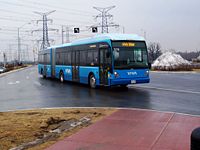
York Region Transit (YRT) connects Markham with surrounding municipalities in York Region, and was created in 2001 from the merger of Markham Transit, Richmond Hill Transit, Newmarket Transit and Vaughan Transit. YRT to connects to the Toronto Transit Commission (TTC) subway system by way of Viva Bus Rapid Transit from Finch station along Yonge Street, and Don Mills station through Unionville and on to Markville Mall.
The TTC also provides service in Markham on several north-south routes, such as Don Mills Road, Warden Avenue, Birchmount Road, McCowan Road and Markham Road. These routes charge riders a double fare if they are travelling across the Steeles border and most Markham residents choose to travel by car instead of public transportation.
GO Transit provides train service on the old trackbed of the Toronto and Nipissing Railway, which connects Markham with downtown Toronto on the Stouffville commuter rail service. The line has stops at several stations in Markham, namely Unionville GO Station, Centennial GO Station, Markham GO Station, and Mount Joy GO Station. The Richmond Hill commuter rail line provides service to the Langstaff GO Station, which straddles Markham and Richmond Hill but is used primarily by residents of west-central Markham and southern Richmond Hill.
Air transportation
Toronto/Buttonville Municipal Airport is one of Canada's top ten airports, which caters to general aviation and business commuter traffic to Ottawa and Montreal. Operators at Buttonville include:
- NexJet Aviation Inc
- Executive Edge Air Charter
- Aviation Limited
- Canadian Flyers International
- AHM Air, to and from Toronto Pearson International Airport
- LCE Aviation, providing private air charters around Southern Ontario and across the continent[5]
- Flightexec, an executive air charter and air ambulance for Ontario Air Ambulance
- Million Air, an executive air charter
- Toronto Airways Limited, a flight training school[6]
- Buttonville Flying Club[7]
- Leggat Aviation Ltd., an authorized Cessna Dealership that specializes in new aircraft sales, full service and parts supply[8]
Notable people from Markham
Athletes
- Saeed Baghbani, karate fighter, Pan American Games gold medalist
- Bill Crothers, track and field athlete, Olympic medalist, chair of the York Region District School Board
- Cody Hodgson, NHL #6 ranked prospect for the 2008 NHL Entry Draft
- Brad May, NHL hockey player, Anaheim Ducks
- Sean Morley, WWE wrestler, known by the ring name "Val Venis"
- Ken Pereira, field hockey player, Pan American Games medalist
- Steven Stamkos, NHL hockey player, Tampa Bay Lightning
- Tammy Sutton-Brown, WNBA basketball player
- Steve Thomas, retired NHL hockey player
- Raffi Torres, NHL hockey player, Columbus Blue Jackets
- Stephen Weiss, NHL hockey player, Florida Panthers
Media
- Steve Byers, actor, Falcon Beach
- Emmanuelle Chriqui, actress, Entourage
- Hayden Christensen, actor, best known for his role as Anakin Skywalker in Star Wars (Episodes 2 and 3)
- Talan Torriero, actor, Laguna Beach: The Real Orange County
Musicians
- Justin Peroff, drummer for the band Broken Social Scene
- Anna Russell, singer and opera parodist
Sister cities
 Cary, North Carolina, USA
Cary, North Carolina, USA Nördlingen, Germany
Nördlingen, Germany Pearland, Texas, USA
Pearland, Texas, USA Wuhan, People's Republic of China[9]
Wuhan, People's Republic of China[9]
References and footnotes
- ↑ "Community highlights for Markham". 2006 Community Profiles. Statistics Canada (2007-03-13). Retrieved on 2007-03-13.
- ↑ 2.0 2.1 "2006 Canadian Census". Statistics Canada. Retrieved on 2007-12-04.
- ↑ 2006 Community Profile
- ↑ 2006 Community Profiles
- ↑ LCE Aviation
- ↑ Toronto Airways Limited
- ↑ Buttonville Flying Club
- ↑ Leggat Aviation
- ↑ Sister Cities International
External links
|
||||||||
 |
Whitchurch-Stouffville, Richmond Hill |
|
|||||
| Vaughan, Richmond Hill | Pickering, Uxbridge | ||||||
| Toronto |
|
||||||||
|
|||||||||||||||||
